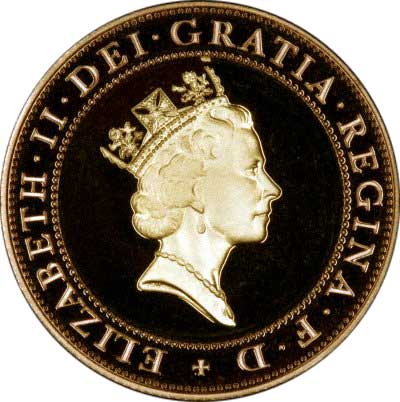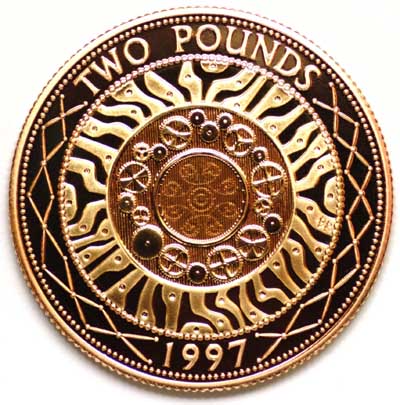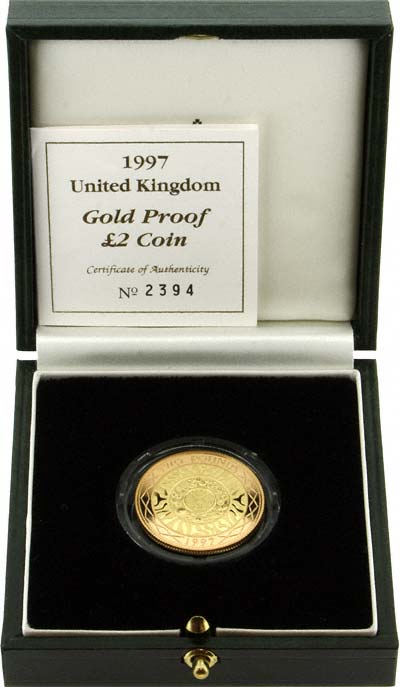1997 First Bimetallic Gold Proof Two Pounds
Since 1986. the Royal Mint has issued two pound coins, both for circulation and as commemorative versions for collectors.
Major Design Change
The five dates and six designs issued between 1986 and 1996 were made of solid nickel brass, and were probably too heavy to be a popular circulating coin. In 1997, the weight was reduced to a more manageable level, and the construction changed to a bi-metallic coin.
The new type of £2 coin introduced in 1997 features an innovative bi-metallic design.
It is the first base metal two pound coin to be intended for circulation in the United Kingdom. It is also the first time that a bi-metallic coin has been used for British coins.
The inner disc is made of cupro-nickel, while the outer ring is made of nickel-brass.
Production Method
After two completely separate blanks have been produced, the outer edge of the nickel-brass blank is raised and edge lettering is applied on a rimming machine. This then passes on to a piercing press which punches out the central hole.
Meanwhile, the cupro-nickel blank has also been rimmed and given a special edge groove to provide a key for the outer nickel-brass ring.
Both blanks are then fed individually into a coining press where the cupro-nickel blank is dropped into the centre of the nickel-brass ring.
The upward movement of the bottom die compresses the blanks against the upper die with a force of around 100 tonnes.
This immense pressure bonds the two blanks together and simultaneously reproduces the milled edge and the obverse and reverse designs.
Obverse
The Third Portrait
The obverse (head side) is the third major portrait of Queen Elizabeth II, designed by Ralph David Maklouf, FRSA.
It came into use in 1985 and continued until 1997 inclusive, a total of thirteen years.
The queen is shown wearing a pearl necklet. In the next year 1998, the portrait changes to the fourth portrait, showing more mature features, and without the necklet.
Reverse
The intricate reverse design comprises four quite different, but complementary, concentric circles radiating outwards from the heart of the coin, and embodies mankind's extraordinary drive, determination and creative genius.
Representing the Iron Age, the inner disc carries the latent feature which, when the coin is tilted, changes the design of the metalwork pattern from a series of four separate whorls into a pattern featuring eight inter-twined whorls.
The first ring, with its arrangement of cogs, gears and wheels, represents the explosion of industrial development which is now referred to as the Industrial Revolution.
Symbolising the computer age, the final cupro-nickel ring is adorned with a pattern derived from a silicon chip, while the outer ring of nickel-brass, with its inter-connecting web of lines, represents the age of the Internet and the information superhighway.
With its continuing outward movement, the design of the 1997 £2 coin skilfully unites both past and present, and alludes to the possibilities the future may hold.
More About The Reverse Design
After announcing that the reverse design of the 1997 £2 coin would be chosen from entries to an open public competition advertised nationwide, and worldwide on the Internet, the Royal Mint was surprised and pleased at the sheer scale of public interest and the volume of response.
Over 1200 entries were received and, as with all new coin designs, the final selection was made after careful examination by an independent body known as the Royal Mint Advisory Committee, presided over by His Royal Highness Prince Philip, Duke of Edinburgh.
Norfolk art teacher Bruce Rushin was travelling home from work when he heard the competition details broadcast on the radio, and spontaneously decided he would channel some of his creative energy into producing a few coin designs.
Bruce Rushin's design was eventually chosen as the winner. The design not only refers back to our ancestral roots, but also places itself firmly in the present, while the astute design of the ever-radiating rings echoes the forward looking ideals of some of our greatest minds.
Technical Problems
We tell elsewhere about the silly rumour surrounding £2 coins with the queen wearing a necklet. Some of these rumours falsely ascribed a rarity value to the ordinary base metal version of this coin for various reasons including one that the Mint were being cautious about, or had production problems with, the bimetallic design, with coins falling apart. In fact, bimetallic coins had been well tested by a number of world mints including the Royal Mint, before 1997.
Considering the Mint goes into some detail about the new production methods, and also that this coin "celebrates the development of technology", it is surprising that the designer chose an odd number of cogwheels, which cannot work, instead of an even number, which would work, and even more surprising that nobody at the Mint bothered to check this before approving the final design. It makes you wonder what the other 1,200 submitted designs were like!
The Royal Mint seem to be slightly sensitive to any criticism we make, but we are aware they used a rather weak standard reply to the numerous comments enquiries they received about the unworkable and impractical design. We will make no further comment here.
Edge
The edge is milled and also carries an incuse inscription.
STANDING ON THE SHOULDERS OF GIANTS
The edge inscription encapsulates perfectly the essence of the reverse design, and has been taken from a letter written by Isaac Newton to fellow scientist Robert Hooke on 5th. February 1676, where he very modestly claimed that his success had been built on the achievement of others: "If I have seen further it is by standing on the shoulders of giants".
It is possible that Benjamin Franklin said it also, but later!
Oasis sang it much later. We look forward to hearing more song lyrics taken from coin inscriptions.
Gold Proof Version
For the gold proof version, the coin is still bi-metallic, and made from two separate pieces, but both are 22 carat gold, with different amounts of silver added.
The inner disc is 22 carat yellow gold, while the outer disc is 22 carat red gold.
Specifications
Prices & Availability
All prices subject to fluctuation.
| Call to check availability |
You may wish to use our order form.
Postage & Packing
UK Registered Post (Special Delivery) £9 per order
EU Insured Post £10 per order
USA Airmail $10,
Insured Shipping $20
Canada Airmail $15,
Insured Shipping via Fedex $60
Base Metal Issue Mintage
Hardly a week goes by without someone offering to sell us one or more of the base metal version of this coin thinking they have got a gold version. These were struck in cupro-nickel and nickel-brass as stated above, and are therefore a yellow and grey in colour. Only a hopelessly over-optimistic person or idiot could confuse these two different version. We also see base metal versions offered on eBay as gold, but then over half the stuff offered on eBay seems to be stolen, fake, or dubious in some other aspect.
The mintage of 1997 base metal two pounds was 13,735,000.
|
|

Obverse of 1997 First Bimetallic £2 Proof
Two Pounds Index

Reverse of First Bimetallic Gold £2 Coin

1997 First Bimetallic Gold £2 Coin in Box
Two Pounds Information
|



